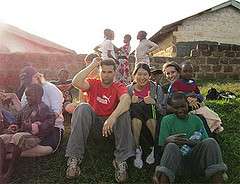Penn State School of International Affairs students Kory Hansen, Jin Ju Kim and Andrea Grzybowski with residents of the Children and Youth Empowerment Center in Nyeri, Kenya.
(Phys.org)—In an effort to bring fresh water to rural Kenyans, School of International Affairs (SIA) students Kory Hansen and Jin Ju Kim participated in Penn State's Humanitarian Engineering and Social Entrepreneurship (HESE) program to develop a ceramic water filtration system for parts of the sub Saharan African nation.
Every year, 3.4 million people die from lack of access to fresh water globally. In East Africa, daily routines include women venturing miles to secure fresh water, and bearing the heavy weight of water containers to secure less-than-desirable water.
Hansen and Kim, replicated a ceramic water filter design from a nonprofit organization, Potters for Peace. The goal was to use no more than two people, $200, and two days, when they built the new design of the water filter, based on available resources in Africa.
The filters, which the students tested and tried on the Penn State campus, removed 99.9 percent of bacteria and reduced the community's burden of water collection which would be a major development in water sanitation if transferred to the rural, East African homes.
According to the students, the project was a continuous learning process. Hansen and Kim discussed the difficulties of having to not only take into account the engineering of the design but cultural, economic, and social considerations of the people as well.
Some stumbling blocks
One of the distinguishable characteristic of the HESE students' design was its incorporation of local African materials, purchased by native merchants to bring costs down and ensure the sustainability of the project in the future. Hansen and Kim encountered some complications with the processes, such as the inability to find silver, an essential element in making the filter.
"The filter itself, made of clay and sawdust, eliminates 80 percent of the bacteria and pathogens. When it is coated in silver, it reacts and makes it 99 percent effective. However, silver is probably the only thing not local, and it had to be imported from India or China," said Hansen.
Adapting to the local materials which were not used in simulations within the classroom resulted in disappointment at times, the students said.
"The water didn't go through the local clay very well. We didn't realize the clay had to be prepared differently. We fired it at the temperature used in the classroom, and the mixture of sand and clay turned to glass and filled the holes that filter the water," said Hansen.
Designing the filter was only one of many challenges. While adequate housing was provided in a local hotel, living in Nyeri, a small town about three hours north of Nairobi between the Aberdare Mountains and Mount Kenya, the students had to adjust to the differences of the lifestyles in Africa. Hansen refers to his many negotiations with local merchants to acquire materials for the filters only to be bewildered by the difficulty of getting around, and noted the challenges of visiting more than 30 stores in a matter of two days for products that could be purchased immediately from a large hardware store in the U.S.
The project was based out of the Children Youth Empowerment Center, which takes in children from families unable to support them. Similar to a boarding school, the center provides meals, recreational activities, job training and education for the children.
Students connected with local community
One of the most rewarding experiences for Hansen was meeting Mark (not his real name), an HIV-positive 13-year-old in the center. Since Mark had no family and is often ostracized from others, they adopted him as a part of their small HESE group. Hansen said Mark made many contributions to the project.
Kim described the difficulties of communication as an international student but described the warm welcome she received by the children, who were excited to braid her hair and play with her. Kim said she also appreciated the beauty of the landscape of Kenya and Tanzania.
In spite of difficulties with the water filter project, the two development students pursued a second project in micro-financing during their trip. They paired with ROSCA, a credit group that works with other institutions and businesses to provide for the financial needs of women. The money is used for school fees, funerals, newborns and children.
The students took a leadership position in the program and are looking at ways to help it evolve. "This project is our baby!" said Kim, discussing their involvement in the economic assistance initiative. The students aim to have the results of the microfinance project published in an international journal later this year, in hopes to achieve cooperation with more African organizations.
In moving forward, both Hansen and Kim said they hope to see the project grow. Hansen is considering taking on a larger role in the project, like alumnus Andrea Grybowski who worked with the program in Africa for about six months after graduation. Likewise, Kim wants to be involved in a similar NGO based out of South Korea, working towards development in sub-Saharan Africa.
"Now I'm realizing my dreams and my goals in international affairs. When I came here, I didn't know how to do poverty reduction. Now I do," said Kim.
Provided by Pennsylvania State University





















